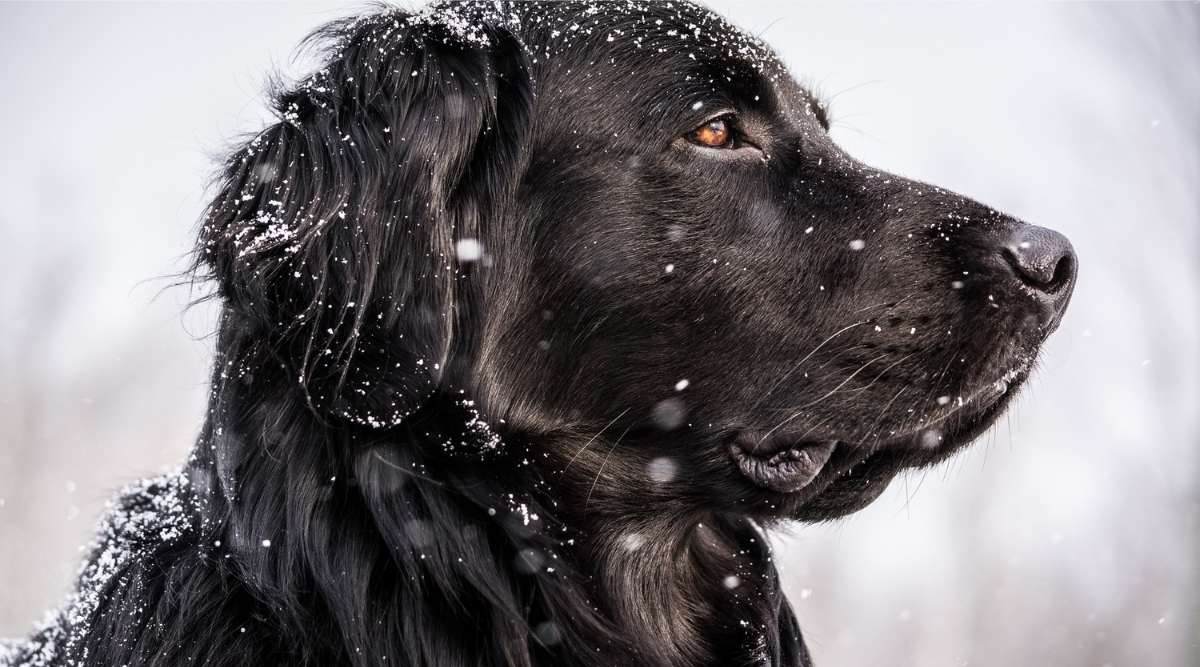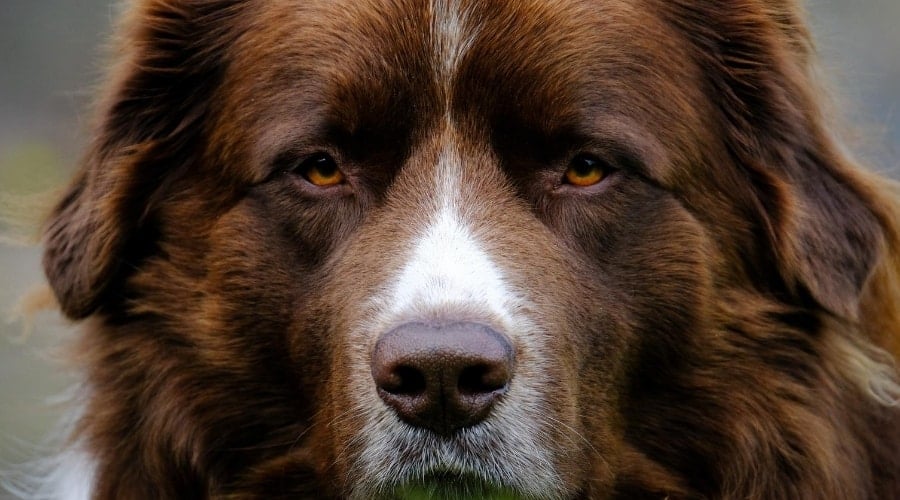Westiepoo Breed Information: Facts, Traits, Pictures & More
When you purchase through links on our site, we may earn a commission. Here’s how it works.
The Westiepoo is a mixed breed and a fantastic blend of the West Highland White Terrier and the Poodle. They are also called the Westiedoodle or Wee-Poos. Their parents are friendly, amusing, people-oriented, and well-balanced breeds, so you can expect the Westiepoo to be all this and more. Like all mixed breeds, they could take after one parent more than the other or be an equal mix of both.
Table of Contents
Westiepoos are small but super sturdy, so don’t let their tiny size fool you. These pups make excellent watchdogs and can eradicate a rodent infestation with their eyes shut. They are entertaining and playful, offering most families endless fun. Plus, there’s plenty of affection and cuddles to go around too. But like all dogs, they need to find the right home for them.
We explore everything you need to know about the Westiepoo and what they need from their humans. So, if you’re wondering whether you are the right owner for one of these pups, you’ve come to the right place. As long as you can provide them with lots of company, attention, and the physical exercise and mental stimulation they need, you will find a best friend here. So, let’s take a closer look at the wonderful Westiepoo.
History
Like most designer breeds, the history of the Westiepoo is unclear. Most designer dogs originate from America during the late 20th century. The Westiepoo is one of the newer mixes, unlike the well-known Labradoodle. Because they are a new mixed breed, the American Kennel Club (AKC) does not recognize them. To get a better understanding of the Westiepoo’s history, let’s take a look at their parent’s breed history.
West Highland White Terrier
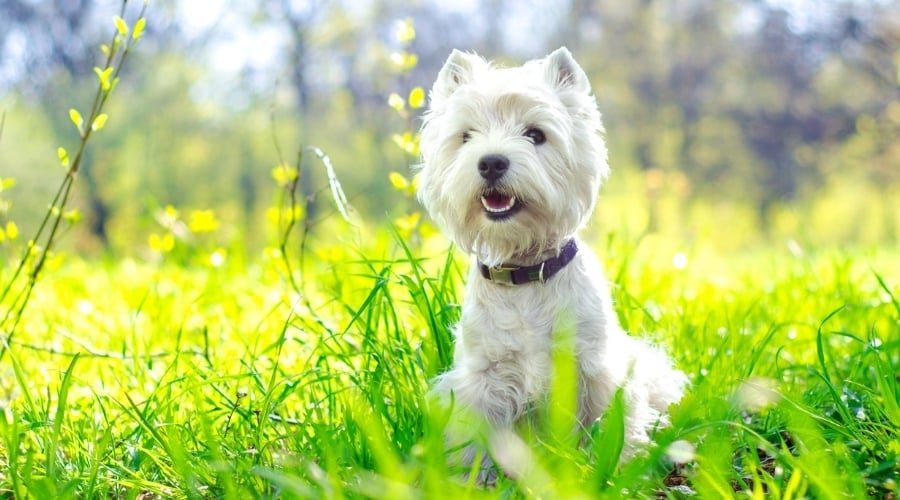
The West Highland White Terrier, known as the Westie, is a tough character canine squashed into a small pooch package. These traits and their sweet, affectionate, and loyal temperament make them ideal family pets for most families. Children tend to love them thanks to their small but hardy size, weighing 15 to 20 pounds. They are healthy pups with an average lifespan of 13 to 15 years.
Westies hail from west Scotland and are one of the many Scottish terrier breeds used as ratters and watchdogs. It is thought that they result from breeding Scottish Terriers and Cairn Terriers. They have been around for at least 100 years, possibly since the 16th century. Now they are a pedigree breed in their own right. The Westie was recognized by the AKC in 1908 and is a popular canine model for companies like Cesar and Juicy Couture.
Poodle

There are three Poodle sizes: toy, miniature, and standard. Most often, Westiepoos have miniature Poodle parents due to their similar size to the Westie, coming in at 10 to 15 pounds. Sometimes toy Poodles are their parents, but very rarely are standard Poodles used, considering the vast size difference. Poodles are one of the most popular breeds in the designer doggy world. Not only do they have sweet and fun personalities, but they are also hypoallergenic, making them suitable for families with allergies.
Poodles come from Germany, and these water dogs were bred to hunt ducks. Their crisp and curly coat protects them from the cold water, and their swimming and retrieving ability is impressive. Poodles are extremely intelligent, loyal, and obedient, which makes training them much more straightforward. The standard Poodle was bred down to the miniature and again to the toy when smaller lap dogs became popular.
Temperament
Westiepoos are a great mix of their parent’s personalities. Both parents are happy-go-lucky pups with a zest for life, so you can be sure your Westiepoo is the same. Expect a fun pooch that brings joy to your day. But with that comes the expectation that they need an equally active and playful family that can keep them stimulated throughout the day. Otherwise, they can become destructive and get up to no good.
Thankfully Westiepoos also have an affectionate and cuddly side, and they love to snuggle up on the sofa with their family. So as long as you meet their exercise needs, you’ll find a fantastic boxset buddy in this pup. Westiepoos are adaptable and highly people-oriented, so there aren’t many homes they couldn’t thrive in.
Westiepoos are generally sociable pups with humans and other dogs. As long as they are socialized well as a puppy, they make friends easily. They like to bark and make their family aware of incoming visitors. And they also have a very high prey drive that you need to be mindful of. Whether it’s a rat or a duck, the Westiepoo might not be able to resist the urge to chase or catch.
Size & Appearance
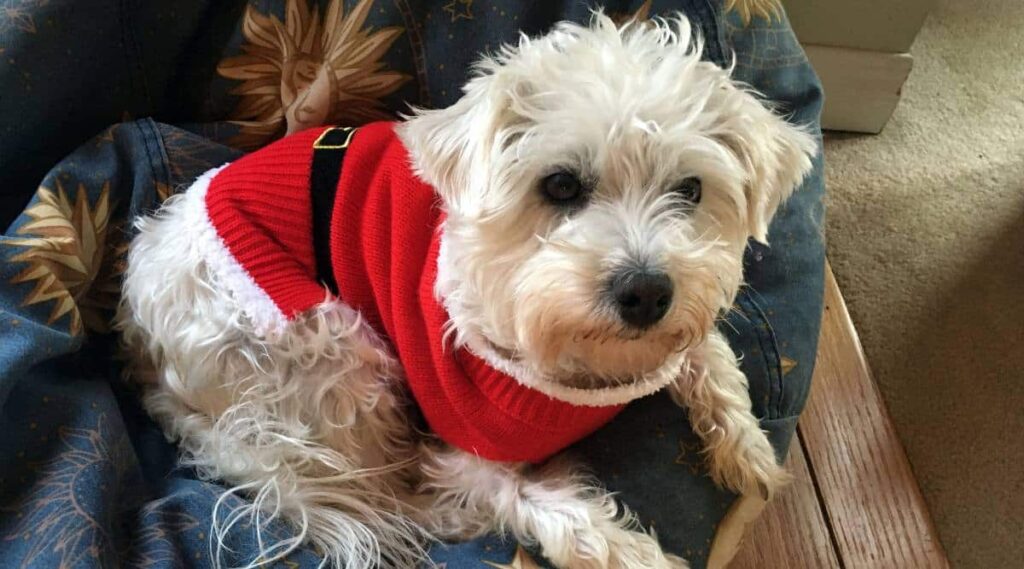
They typically weigh between 10 and 20 pounds and measure between 10 and 15 inches tall, from paw to shoulder. Males are usually larger than their female counterparts. If the size of your Westiepoo is important, you need to establish what size Poodle parent your Westiepoo has. There is a considerable difference between toy, miniature, and standard Poodles, and it determines the sizes of their mixed pups.
As mixed breeds, Westiepoos have a varied appearance depending on which parent they take after. Regardless of what parent they take after, you can expect large, round, dark-colored eyes with a cheeky gaze. Their smiles are infectious. Westies have erect, pointy ears, and Poodles have larger, drop-down ears. Your Westiepoo might inherit one of each giving them a quirky look.
Coat & Colors

Usually, Westiepoos have a wavy or scruffy coat. Westies have scruffy coats with loose waves, whereas Poodles have tightly curled coats. Your mixed breed pup’s coat can fall anywhere in between. Both parents are hypoallergenic dogs, even though the Westie has a double-layered coat. Westiepoos can inherit one or two coat layers.
A Westiepoo coat is typically light in color. Westies are always white, whereas Poodles have many coat colors. Common Westiepoo colors are white, cream, tan, and apricot. It is uncommon for Westiepoos to have a highly contrasting mixed-color coat like some Poodles, although they might have a soft blend of light color throughout.
Exercise & Living Conditions
Both the miniature Poodle and the Westie are medium-energy dogs. The Westiepoo’s little legs mean they don’t need more than an hour’s daily exercise. But they need more than just a walk around the block. Aim for around 45 minutes of exercise every day for the average Westiepoo. Their exercise needs to be playful, exciting, and challenging to burn up their intelligent energy and test their terrier genes. They also need plenty of interactive playtime and challenging toys for solo play too.
As you know, the Westiepoo has a high prey drive. This means they need a secure home and yard they cannot escape because they chase everything in sight. These dogs focus on their prey so much that they ignore live traffic. Their prey drive also means that they need to be on a leash at all times. And they aren’t the best canine for households with rodents, birds, or other smaller pets. Squeaky toys are a great way to satisfy their inner hunter.
Westiepoos are companion canines, and their family must be around most of the day. Although the Westie bloodline is more independent and less anxious than some Poodles, this pup doesn’t like to be left alone for too long. Separation anxiety can be an issue and something to consider if you work long hours away from home.
Training
Westiepoos are generally eager to please their owners and relatively simple to train. Like most terriers, Westies have a stubborn streak that can make training tricky. Thankfully, the super-intelligent and biddable Poodle influence makes training Westiepoos easier. Positive reinforcement training is the best way to train your Westiepoo, especially as they can be sensitive to harsher training methods.
Socializing your Westiepoo is crucial in building their confidence and happiness and creating a well-balanced adult. Mix them with as many other dogs, humans, and new situations as possible from a young age. It’s also important to recognize the difference between rewarding behavior and spoiling a dog. Something called “small dog syndrome” is evident in many small dogs like the Westiepoo.
As the Westiepoo doesn’t like to be left alone for too long, it’s a great idea to crate train them. It also means they haven’t got access to your home and all the chewable objects in sight, keeping them out of trouble or danger’s way. Not only do studies show that crate training reduces anxiety in dogs, but it doesn’t take long for them to love their crate space.
Health
Westiepoos are typically healthy dog breeds that enjoy a healthy average lifespan of up to 15 years. With all dogs, there are several health conditions in their parent’s bloodline to be aware of. Let’s take a closer look at the most common health concerns in the Westiepoo.
Eye Conditions
Like most breeds, Westiepoos are susceptible to several eye conditions. The most common disorders are progressive retinal atrophy (PRA) and age-related cataracts. PRA is an inherited and degenerative disease that can eventually lead to blindness. Although it isn’t painful, vision impairment and loss can lead to a lower quality of life and an increased risk of injury.
Hip Dysplasia
Hip dysplasia is more common in larger dogs, but the Westiepoo is still susceptible to this condition. It is caused by an abnormal formation of the joint, which can cause mobility issues and arthritic pain. A high-quality diet, especially in the developmental years, is one of the ways you can assist with healthy musculoskeletal formation. Be sure to ask your breeder for the parent’s hip scores too.
Legg-Calve-Perthes
This orthopedic disorder causes degeneration of the hip joint, leading to bone and joint inflammation and disintegration of the hip joint. It is more common in smaller dog breeds, although it is often confused for hip dysplasia and vice versa. Look out for symptoms such as lameness, thigh muscle wastage, and pain when moving.
Patellar Luxation
This orthopedic condition describes the dislocation of the kneecap, which is why it is commonly referred to as the floating kneecap. It is more common in smaller breeds like the Westiepoo. The most common symptom is skipping on one of the limbs. Most affected dogs only require corrective management on one or a few occasions. But if your pooch has a severe case, they might benefit from surgical correction.
Nutrition
Westiepoos are small-size pups which means they have small-size bowls. How much they eat depends on various factors, including their age, size, sex, activity levels, and the type of diet you feed them. Always consult your vet or the package instructions about how much to feed your Westiepoo. Feeding them too much can lead to weight gain. This could be detrimental to their health, considering they are already predisposed to several joint conditions.
Choosing an age-appropriate diet is essential, especially during their first year. It should also be a high-quality diet that meets the Association of American Feed Control Officials (AAFCO) standards. Look for high-quality ingredients such as animal-based protein, healthy fats, vitamins, and minerals. Why not consider one of the country’s leading fresh subscription services, such as The Farmer’s Dog?
Grooming
Depending on the type of coat your Westiepoo inherits depends on their grooming needs. If they inherit the tighter curls of their Poodle parent, they need a brush designed for Poodles. Or if they have the straighter but scruffy hair of the Westie, a more generic brush will do. If they have a single coat, you want a brush with softer ends to prevent skin irritation. And if they have a double coat, an undercoat rake brush could benefit their regime. Either way, Westiepoos need brushing several times weekly to keep their longer-than-average locks untangled and dirt-free.
Westiepoos have small mouths with compact teeth, so they need a strict dental regime from an early age. This prevents periodontal disease and helps to keep their breath fresh. Depending on how dirty they become, they only need several baths a year. Be sure to use a shampoo designed for dogs, preferably with gentle and natural ingredients like oatmeal.
Breeders & Puppy Costs
Westiepoos are becoming an increasingly popular mixed breed but aren’t as popular as many others, like a Cockapoo. You might have to travel further afield to find a responsible Westiepoo breeder. However, working with a responsible breeder who strives to breed healthy pups is essential. There are many signs of an ethical breeder, such as allowing you to meet the puppies beforehand, being able to produce health certificates, and having the ability to answer questions knowledgeably. Be aware of the tactics irresponsible breeders use.
The average starting price of a Westiepoo puppy is around $1,000. As a relatively new mixed breed and not a hugely popular or well-known one, the puppy price shouldn’t go beyond much more than this. You must consider the costs of getting your home ready for a puppy and ongoing costs such as food and pet insurance.
Rescues & Shelters
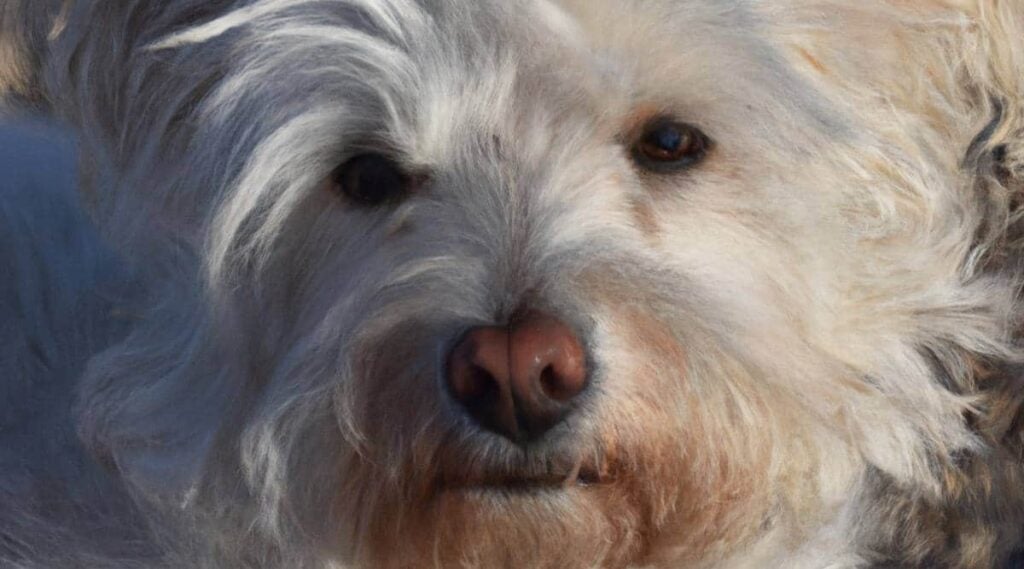
The Westiepoo is a relatively rare mix breed, so finding one in a rescue shelter is rare. If you find one you like, snap them up quickly because they won’t hang around long. Alternatively, try online rescue organizations focusing on rehoming Westie and Poodle mixes. The costs of rescuing a Westiepoo are likely to be lower than buying a puppy.
As A Family Pet
- This is a small mix breed weighing between 10 and 20 pounds.
- Westiepoos are fun and entertaining, needing plenty of mental stimulation throughout the day.
- These pups need around 45 minutes of exercise daily.
- They do not like to be left alone for too long.
- They have an incredibly high prey drive.
- Westiepoos love people and are affectionate with their families.
- Most of these pups make well-balanced, family-friendly pets.
- Their coat color and types range, and they need brushing several times weekly.
- Westiepoos can take after one parent more than the other or be an equal blend of both.
- They are adaptable and can live with most children and dogs.
Final Thoughts
The Westiepoo is a wonderful mix breed with great canine qualities from the Poodle and the Westie. They can make brilliant family pets, just as long as you don’t have any pet rats or ducks. Their comical and charismatic personality brightens any room they walk into, forever showing off their playful and fun side. But they also have a calm and affectionate character, offering families a well-balanced canine companion. Always work with a reputable breeder if you want a healthy pup, and remember to ask what size Poodle their parent is.
